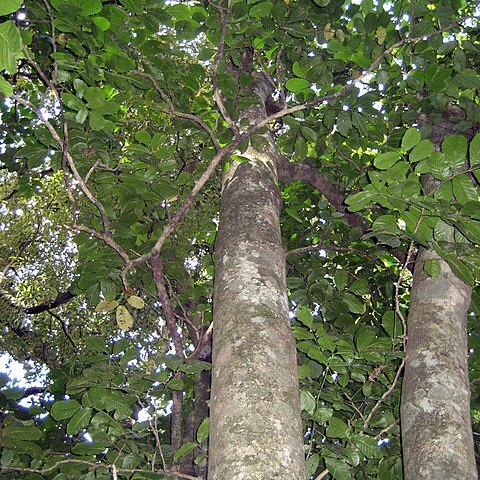Tree up to c. 15 m. tall; trunk up to ± 1 m. diam.; branches stout, bark pale. Lvs imparipinnate, alt., on petioles up to 4 cm. long, pulvinate at base; lflt-pairs us. 4, opp. or subopp., on pulvinate petiolules up to ± 1·5 cm. long. Lamina (5)-7-15-(20) × (2)-3-4-(8) cm., somewhat obliquely ovate-to obovate-oblong, coriac., abruptly bluntly pointed, undulate. Lateral veins at wide angle, prominent. Infl. us. cauliflorous; fls up to ± 3 cm. diam., in drooping panicles up to ± 4 dm. long; pedicels short. Calyx divided to base; lobes broad-oblong, abruptly pointed, ciliate. Petals linear, spreading, waxy white, up to 10 mm. or more long. Staminal column cylindric, fleshy, toothed; anthers subsessile. Style ± silky-hairy; stigma discoid, slightly exserted, surrounded by thin concentric cup. Capsule broad-obovoid to subglobose, 3-4-celled, ± 25 mm. long,. on thickened pedicel. Seeds 2 per cell; aril orange to scarlet.
More
A tree with a stout column like trunk. It grows about 8 m high. The crown is rounded. The leaves are large and glossy. They have leaflets along the stalk. The flowers are greenish-white and waxy and hang in droops. They grow on the trunks and branches. They can be 30 cm long. The fruit capsule has 3-4 cells. They are 2.5 cm across. It opens after 15 months to reveal 2 seeds in a fleshy red aril.
It grows in lowland and coastal regions in New Zealand. It is mostly in damp locations. It is best in deep, moist loam soils. It needs a protected, sunny position. It is resistant to frost and damaged by drought.
More
Lowland forest in coastal regions of North and South Islands.

